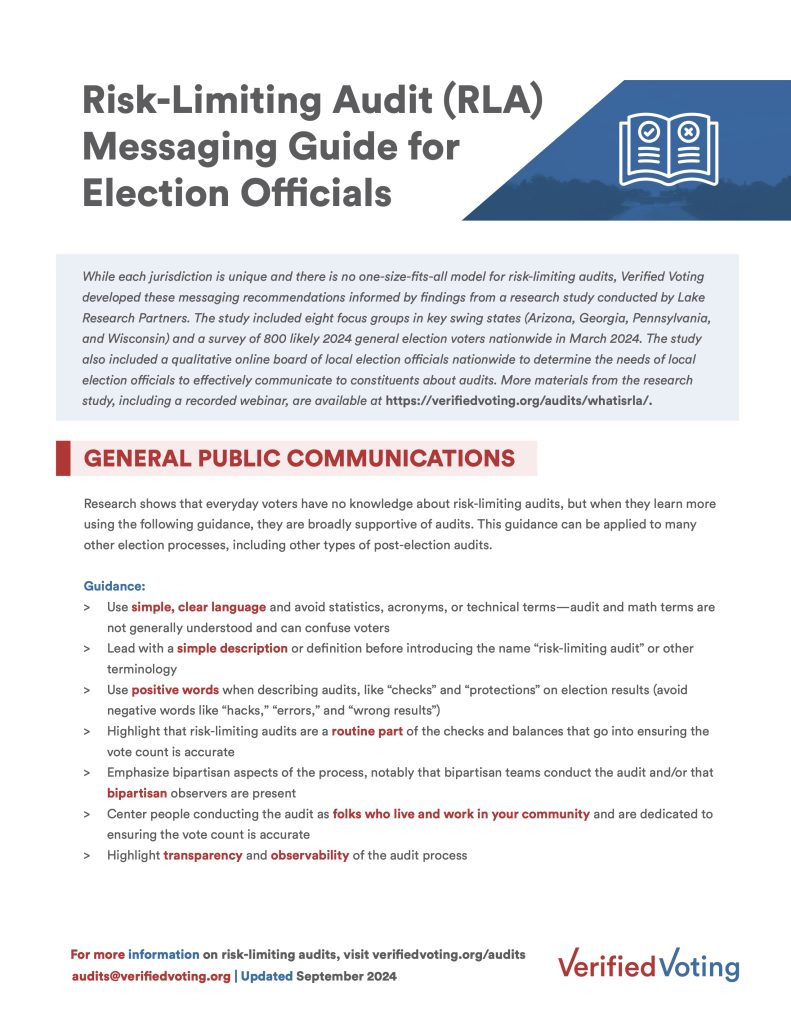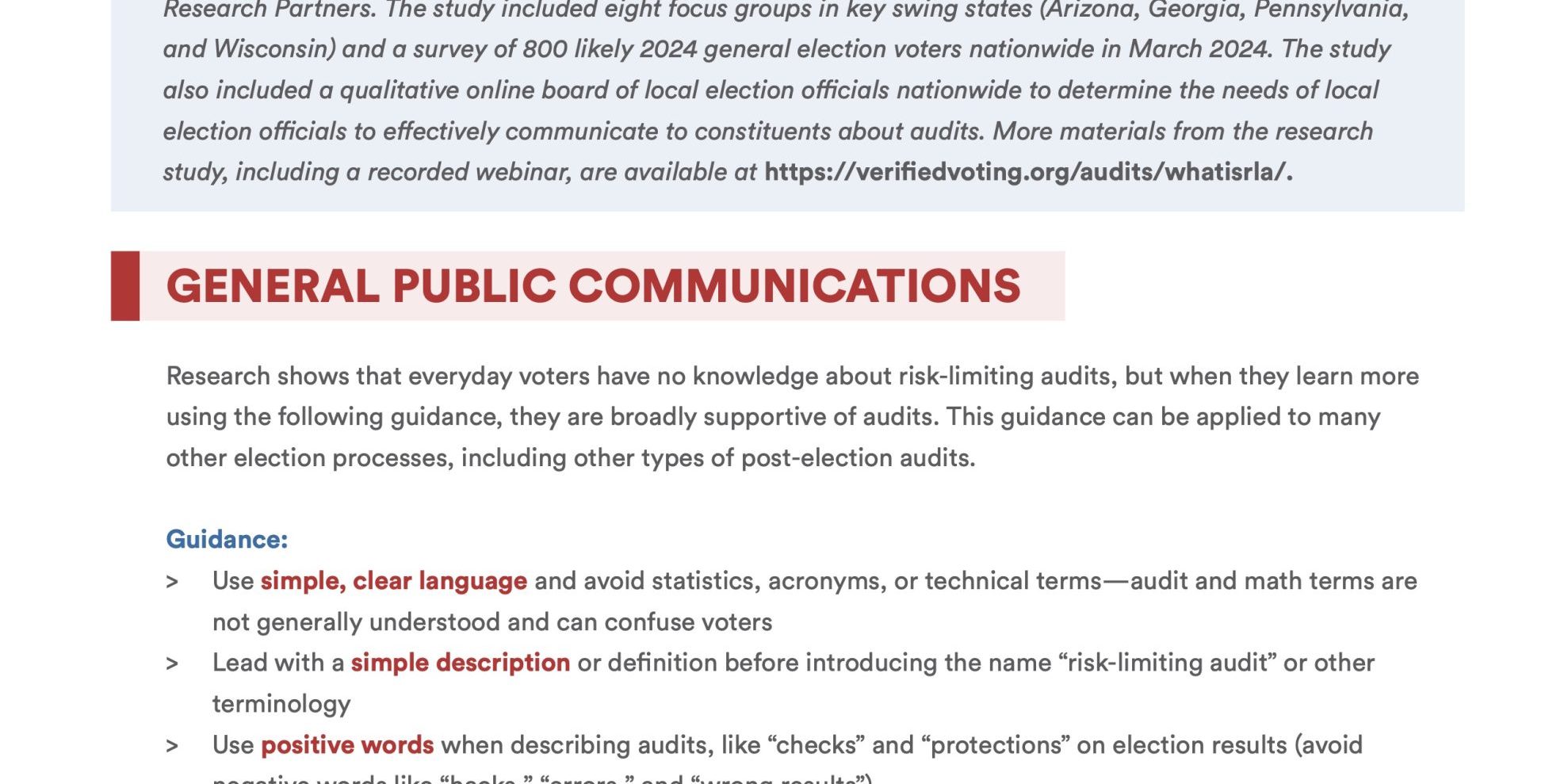
resource
Risk-Limiting Audit (RLA) Messaging Guide for Election Officials
Date: September 2024
Author: Verified Voting
Issue: Post-Election Audit
Publication Information
While each jurisdiction is unique and there is no one-size-fits-all model for risk-limiting audits, Verified Voting developed these messaging recommendations informed by findings from a research study conducted by Lake Research Partners. The study included eight focus groups in key swing states (Arizona, Georgia, Pennsylvania, and Wisconsin) and a survey of 800 likely 2024 general election voters nationwide in March 2024. The study also included a qualitative online board of local election officials nationwide to determine the needs of local election officials to effectively communicate to constituents about audits. More materials from the research study, including a recorded webinar, are available at https://verifiedvoting.org/audits/whatisrla/.
GENERAL PUBLIC COMMUNICATIONS
Research shows that everyday voters have no knowledge about risk-limiting audits, but when they learn more using the following guidance, they are broadly supportive of audits. This guidance can be applied to many other election processes, including other types of post-election audits.
Guidance:
- Use simple, clear language and avoid statistics, acronyms, or technical terms—audit and math terms are not generally understood and can confuse voters
- Lead with a simple description or definition before introducing the name “risk-limiting audit” or other terminology
- Use positive words when describing audits, like “checks” and “protections” on election results (avoid negative words like “hacks” and “errors” that could produce wrong results)
- Highlight that risk-limiting audits are a routine part of the checks and balances that go into ensuring the vote count is accurate
- Emphasize bipartisan aspects of the process, notably that bipartisan teams conduct the audit and/or that bipartisan observers are present
- Center folks conducting the audit as folks who live and work in your community and are dedicated to ensuring the vote count is accurate
- Highlight transparency and observability of the audit process
Sample messages:
- We’re doing a routine, transparent check to confirm the election results, called a risk-limiting audit.
- This audit/check is done by election workers who are sworn to impartiality, often working in [non-partisan or bipartisan] teams to ensure that neither party has influence over the process.
- The public is welcome and encouraged to attend—audits are observed by folks in our community at every stage and we want the process to be as transparent as possible.
- As soon as the audit is finished, we’ll report the results publicly so you know it was done fairly.
- [If audit confirms outcome with minimal or no discrepancies] The audit, combined with all of the other processes we have in place, provides strong evidence that [Candidate] won.
- [If substantial discrepancies are found]: This is one of the reasons why we do audits—to check the unofficial results before the election is certified. Discrepancies sometimes happen and we proceeded to do [name the process, like a recount] to ensure that every vote counted.
Guidance on using “risk-limiting audit”: Research showed that the public has little understanding of the term “risk-limiting audit” and had negative reactions to the word “risk”. While the election technology community has adopted this name for years, research shows that this moniker is not intuitive to the general public. If we want to convey to everyday voters what “risk-limiting audits” do as well as instill confidence in them, it’s clear we need to find other ways to refer to them. Verified Voting recommends keeping it simple and referring to them as “audits”, “checks”, or another clear, positive word.
MEDIA, ADVOCATES, OBSERVERS, AND EXPERTS
Election officials are tasked with communicating to the general public who seek straightforward, simple, “non wonky” information. However, key stakeholders like the media, advocates, observers, and election experts may request detailed information about the process (and could already be familiar with the term “risk-limiting audit”). Verified Voting recommends having the following information readily available and published online:
- Summary results— which candidate was confirmed as winner, how many ballots were audited, how many discrepancies were found, and any actions taken to remediate discrepancies (or actions that will be taken in future elections)
- Timeline— when the audit was conducted and completed
- Who conducted the audit— how workers and teams were chosen, noting bipartisan or nonpartisan teams and if they signed/ took an oath/pledge
- Transparency measures— how the audit was advertised and how it was publicly observable (note any observation turnout numbers or other analytics, like online streaming stats)
- Technical details— the risk-limiting audit method used, the risk limit, how the random seed was chosen, the size of the sample (how many ballots and/or batches audited)
- All audit materials, including data files and official reports
RISK-LIMITING AUDIT TECHNICAL DEFINITIONS
Here are definitions of common terminology used to describe risk-limiting audits and various processes. We generally recommend avoiding these terms when communicating with everyday voters.
- Risk-limiting audit (RLA): A type of post-election audit that helps ensure—and reassure the public—that reported winners really got more votes. RLAs are considered a rigorous, efficient, and cost-effective tool for election officials. They can confirm that the unofficial election outcome matches the ballots cast, or trigger a full hand count to correct the outcome before the election results are certified. Learn more at https://verifiedvoting.org/publication/what-is-a-risk-limiting-audit/
- Risk-limiting audit pilots: These are test runs for jurisdictions. Learn more at https://verifiedvoting.org/publication/about-rla-pilots
- Risk limit: The “risk limit” describes the maximum chance that the audit is wrong. For instance, a 5% risk limit means that if the election outcome is wrong, the chance that the audit will mistakenly confirm it is 5% or less
- Sample size & margin of victory: Close contests, where the winner’s margin of victory is small, require looking at larger samples of ballots to check the outcome
SAMPLE PROMOTION MATERIALS
Video:
Voters in our research study give near-universally positive feedback on this 75 second video explaining risk-limiting audits. They think the video is simple, informative, and clear. The animations are easy to follow and help voters understand the concept of auditing an election. Your jurisdiction is welcome to share this video with your constituents, available at https://youtu.be/DlstGHazHPM?si=cztRldd-ChbjyvCp. Contact press@verifiedvoting.org for the raw file.
Sample social media graphics:
Sample social media graphics are available here.
For more information on risk-limiting audits, visit www.verifiedvoting.org/audits.
